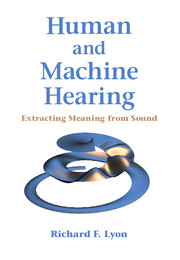Book contents
- Frontmatter
- Dedication
- Contents
- Foreword
- Preface
- Part I Sound Analysis and Representation Overview
- Part II Systems Theory for Hearing
- Part III The Auditory Periphery
- Part IV The Auditory Nervous System
- 20 Auditory Nerve and Cochlear Nucleus
- 21 The Auditory Image
- 22 Binaural Spatial Hearing
- 23 The Auditory Brain
- Part V Learning and Applications
- Bibliography
- Author Index
- Subject Index
- Plate section
20 - Auditory Nerve and Cochlear Nucleus
from Part IV - The Auditory Nervous System
Published online by Cambridge University Press: 28 April 2017
- Frontmatter
- Dedication
- Contents
- Foreword
- Preface
- Part I Sound Analysis and Representation Overview
- Part II Systems Theory for Hearing
- Part III The Auditory Periphery
- Part IV The Auditory Nervous System
- 20 Auditory Nerve and Cochlear Nucleus
- 21 The Auditory Image
- 22 Binaural Spatial Hearing
- 23 The Auditory Brain
- Part V Learning and Applications
- Bibliography
- Author Index
- Subject Index
- Plate section
Summary
I experimented in this way, and eventually found that I could send as many as 352 impulses per second along the nerve of a rabbit and get a note from the muscle of the pitch of 352 vibrations per second … but when I tried by more rapid stimulation of the nerve to get a higher note from the muscle, I failed. … Now, am I to conclude that, because I failed to get a higher note than one of 352 vibrations from the muscle, it is not possible to send more than 352 vibrations per second along a nerve? By no means …
—“A lecture on the sense of hearing,” Rutherford (1887)The auditory nerve (AN), originating in the spiral ganglion in the cochlea, carries the output signals of the cochlea's IHCs into the same-side (ipsilateral) cochlear nucleus (CN) in the brainstem, just a few centimeters away, as shown in Figure 20.1. To a large extent, the inputs and outputs of the CN tell us what information the brain is getting from the ear, and what the important first steps are in processing that information.
Observations of physiological behavior of the CN support our emphasis on the use of fine temporal structure in sound representation, as in the Fletcher (1930) “space– time pattern theory” and the Wever and Bray (1930b) “volley theory” that we reviewed in Chapter 2. The CN's inputs and outputs are events, synchronized to sound waveform structure in a very precise and robust way in some parts of the CN, but less synchronized in other parts, serving different subsequent processing pathways.
In the CN, pathways diverge in support of a number of processing functions in parallel, variously specialized for binaural processing, for periodicity detection, and for other monaural feature extraction. The tonotopic organization of the auditory nerve is maintained as a spatial dimension, and various subsequent brain areas use another spatial dimension to organize the extracted features into what we call auditory images, of various sorts.
- Type
- Chapter
- Information
- Human and Machine HearingExtracting Meaning from Sound, pp. 347 - 354Publisher: Cambridge University PressPrint publication year: 2017



